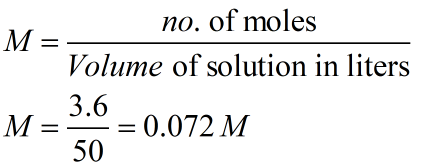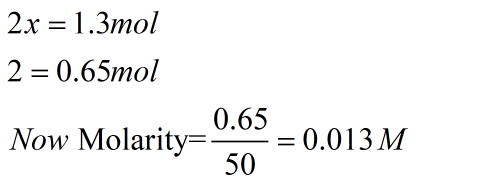Chemistry
10th Edition
ISBN:9781305957404
Author:Steven S. Zumdahl, Susan A. Zumdahl, Donald J. DeCoste
Publisher:Steven S. Zumdahl, Susan A. Zumdahl, Donald J. DeCoste
Chapter1: Chemical Foundations
Section: Chapter Questions
Problem 1RQ: Define and explain the differences between the following terms. a. law and theory b. theory and...
Related questions
Question
![### Combustion of Ammonia: Equilibrium Concentration Calculation
Ammonia has been studied as an alternative "clean" fuel for internal combustion engines, since its reaction with oxygen produces only nitrogen and water vapor, and in the liquid form it is easily transported. An industrial chemist studying this reaction fills a 50.0 L tank with 3.6 mol of ammonia gas and 4.5 mol of oxygen gas, and when the mixture has come to equilibrium measures the amount of nitrogen gas to be 1.3 mol.
#### Task
Calculate the concentration equilibrium constant (Kc) for the combustion of ammonia at the final temperature of the mixture. Round your answer to 2 significant digits.
#### Diagram/Graph Interpretation (if applicable)
There are no specific graphs or diagrams associated with this text.
#### Input Field
\[ K_c = \boxed{\phantom{0000}} \]
- **Interactive Buttons**:
- \( \boxed{}_{10} \): Represents a button used for inputting a power of ten.
- \( \times \): Clears the input field.
- \( \circlearrowright \): Resets the problem.
- \( ? \): Provides hints or additional help.
> Ensure to perform the calculations considering the stoichiometry of the reaction and use the values provided to determine the equilibrium constant accurately.](/v2/_next/image?url=https%3A%2F%2Fcontent.bartleby.com%2Fqna-images%2Fquestion%2Feadc81de-613f-46f4-aced-a703abfea63b%2F88a320d8-0519-40ed-a927-ff4895043bed%2Fmewq1bb.png&w=3840&q=75)
Transcribed Image Text:### Combustion of Ammonia: Equilibrium Concentration Calculation
Ammonia has been studied as an alternative "clean" fuel for internal combustion engines, since its reaction with oxygen produces only nitrogen and water vapor, and in the liquid form it is easily transported. An industrial chemist studying this reaction fills a 50.0 L tank with 3.6 mol of ammonia gas and 4.5 mol of oxygen gas, and when the mixture has come to equilibrium measures the amount of nitrogen gas to be 1.3 mol.
#### Task
Calculate the concentration equilibrium constant (Kc) for the combustion of ammonia at the final temperature of the mixture. Round your answer to 2 significant digits.
#### Diagram/Graph Interpretation (if applicable)
There are no specific graphs or diagrams associated with this text.
#### Input Field
\[ K_c = \boxed{\phantom{0000}} \]
- **Interactive Buttons**:
- \( \boxed{}_{10} \): Represents a button used for inputting a power of ten.
- \( \times \): Clears the input field.
- \( \circlearrowright \): Resets the problem.
- \( ? \): Provides hints or additional help.
> Ensure to perform the calculations considering the stoichiometry of the reaction and use the values provided to determine the equilibrium constant accurately.
Expert Solution
Step 1
Equilibrium constant expression is ratio of concentrations of products over the reactants.
Step 2
From given volume and moles, find the molarity.
Volume of tank= 50L
Molarity of ammonia gas,

Similarly for oxygen gas,

Equation be:

Step 3
Equilibrium concentration be calculated by:
|
4NH3 |
3O2 |
2N2 |
6H2O |
|
0.072 |
0.09 |
0 |
0 |
|
0.072-4x |
0.09-3x |
-2x |
-6x |
Thus, Given is the amount of nitrogen gas 1.3 mol when mixture has come to equilibrium.

Step by step
Solved in 5 steps with 6 images

Knowledge Booster
Learn more about
Need a deep-dive on the concept behind this application? Look no further. Learn more about this topic, chemistry and related others by exploring similar questions and additional content below.Recommended textbooks for you

Chemistry
Chemistry
ISBN:
9781305957404
Author:
Steven S. Zumdahl, Susan A. Zumdahl, Donald J. DeCoste
Publisher:
Cengage Learning

Chemistry
Chemistry
ISBN:
9781259911156
Author:
Raymond Chang Dr., Jason Overby Professor
Publisher:
McGraw-Hill Education

Principles of Instrumental Analysis
Chemistry
ISBN:
9781305577213
Author:
Douglas A. Skoog, F. James Holler, Stanley R. Crouch
Publisher:
Cengage Learning

Chemistry
Chemistry
ISBN:
9781305957404
Author:
Steven S. Zumdahl, Susan A. Zumdahl, Donald J. DeCoste
Publisher:
Cengage Learning

Chemistry
Chemistry
ISBN:
9781259911156
Author:
Raymond Chang Dr., Jason Overby Professor
Publisher:
McGraw-Hill Education

Principles of Instrumental Analysis
Chemistry
ISBN:
9781305577213
Author:
Douglas A. Skoog, F. James Holler, Stanley R. Crouch
Publisher:
Cengage Learning

Organic Chemistry
Chemistry
ISBN:
9780078021558
Author:
Janice Gorzynski Smith Dr.
Publisher:
McGraw-Hill Education

Chemistry: Principles and Reactions
Chemistry
ISBN:
9781305079373
Author:
William L. Masterton, Cecile N. Hurley
Publisher:
Cengage Learning

Elementary Principles of Chemical Processes, Bind…
Chemistry
ISBN:
9781118431221
Author:
Richard M. Felder, Ronald W. Rousseau, Lisa G. Bullard
Publisher:
WILEY